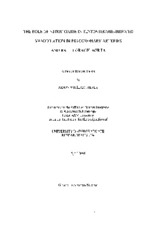| dc.creator | Piefer, Jason William | |
| dc.date.accessioned | 2013-02-22T20:40:27Z | |
| dc.date.available | 2013-02-22T20:40:27Z | |
| dc.date.created | 2001 | |
| dc.date.issued | 2013-02-22 | |
| dc.identifier.uri | https://hdl.handle.net/1969.1/ETD-TAMU-2001-Fellows-Thesis-P4324 | |
| dc.description | Due to the character of the original source materials and the nature of batch digitization, quality control issues may be present in this document. Please report any quality issues you encounter to digital@library.tamu.edu, referencing the URI of the item. | en |
| dc.description | Includes bibliographical references (leaves 25-26). | en |
| dc.description.abstract | Several studies have provided evidence that the administration of testosterone to vascular tissue causes vasodilation (Costarella, Yue). This study examines the role of nitric oxide (NO) as a potential mechanism of testosterone-induced vasodilation. This report includes a functional study that indirectly examined the role of NO and a study to determine an appropriate experimental set up to directly measure NO in vitro. In the functional study, the right coronary arteries and left anterior descending arteries from exercised and sedentary, female Yucatan Mini-Swine were treated with N[]-nitro-L-arginine methyl ester (L-NAME) to inhibit nitric oxide synthase (NOS). Following blockade of NOS, seven cumulative doses (5 []M to 300 []M) of testosterone produced dose-dependent relaxation and resulted in maximal relaxation. This confirms that NO is not the only mediator of testosterone-induced vasodilation. In addition, this study suggests that NO plays a significant role in the mechanism of testosterone-induced dilation in coronary arteries of exercised pigs, while it plays little or no role in the coronary arteries of sedentary pigs. The second part of this study includes the determination of an appropriate experimental set up to directly measure NO release from the thoracic aorta of male and female Sprague-Dawley rats. The experimental set up has to account for the NO-sensitive probe being temperature sensitive, and responding to mechanical stress, acetylcholine (ACh), and background noise. An in vitro experimental set up involving the insertion of a 30 []m probe (World Precision Instruments) into the lumen of the rat thoracic aorta appears to be the most promising method. To test the viability of the set up, the response of the probe to acetylcholine was measured. A detectable response has not been measured, which indicates that the probe should not respond in the presence of tissue unless NO is released. To date, detectable measurements of NO from tissue following the administration of ACh have not been made. This indicates that the experimental set up needs further modification. In combination with functional studies, the direct measurement of NO could definitively determine the role of NO in testosterone-induced vasodilation. | en |
| dc.format.medium | electronic | en |
| dc.format.mimetype | application/pdf | |
| dc.language.iso | en_US | |
| dc.publisher | Texas A&M University | |
| dc.rights | This thesis was part of a retrospective digitization project authorized by the Texas A&M University Libraries in 2008. Copyright remains vested with the author(s). It is the user's responsibility to secure permission from the copyright holder(s) for re-use of the work beyond the provision of Fair Use. | en |
| dc.subject | biomedical science. | en |
| dc.subject | Major biomedical science. | en |
| dc.title | The role of nitric oxide in testosterone-induced vasodilation in pig coronary arteries and rat thoracic aorta | en |
| thesis.degree.department | biomedical science | en |
| thesis.degree.discipline | biomedical science | en |
| thesis.degree.name | Fellows Thesis | en |
| thesis.degree.level | Undergraduate | en |
| dc.type.genre | thesis | en |
| dc.type.material | text | en |
| dc.format.digitalOrigin | reformatted digital | en |


